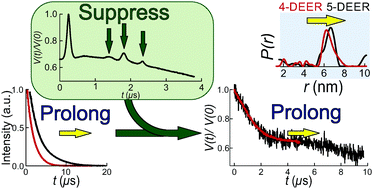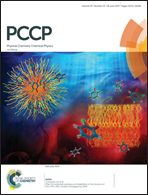Artefact suppression in 5-pulse double electron electron resonance for distance distribution measurements†
Abstract
A 5-pulse version of the Double Electron Electron Resonance (DEER) experiment with Carr–Purcell delays and an additional pump pulse has been shown to significantly extend the experimentally accessible distance range in cases where nuclear spin diffusion dominates electron spin phase memory loss [Borbat et al., J. Phys. Chem. Lett., 2013, 4, 170]. We show that the sequence also prolongs coherence decay for spin labels in or near lipid bilayers, where this decay is mono-exponential. Compared to 4-pulse DEER, 5-pulse DEER suffers from additional artefacts that stem from pulse imperfection and excitation band overlap. Only some of these artefacts can be suppressed by phase cycling and the remaining ones have hindered widespread utilization of the method. Here, we report previously unknown additional artefact contributions stemming from overlap between the excitation bands of the microwave pulses that introduce additional dipolar evolution pathways. Experimental conditions are analyzed in detail that suppress these as well as the already known artefacts. Such suppression results in data that contain at most the partial excitation artefact, which can be deliberately shifted in time by a change in pulse timing without affecting the wanted contribution.



 Please wait while we load your content...
Please wait while we load your content...